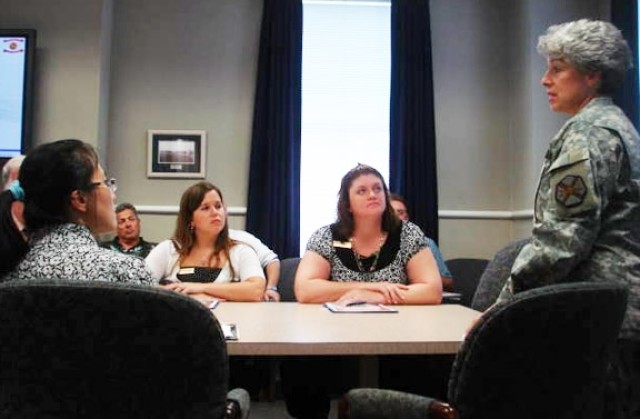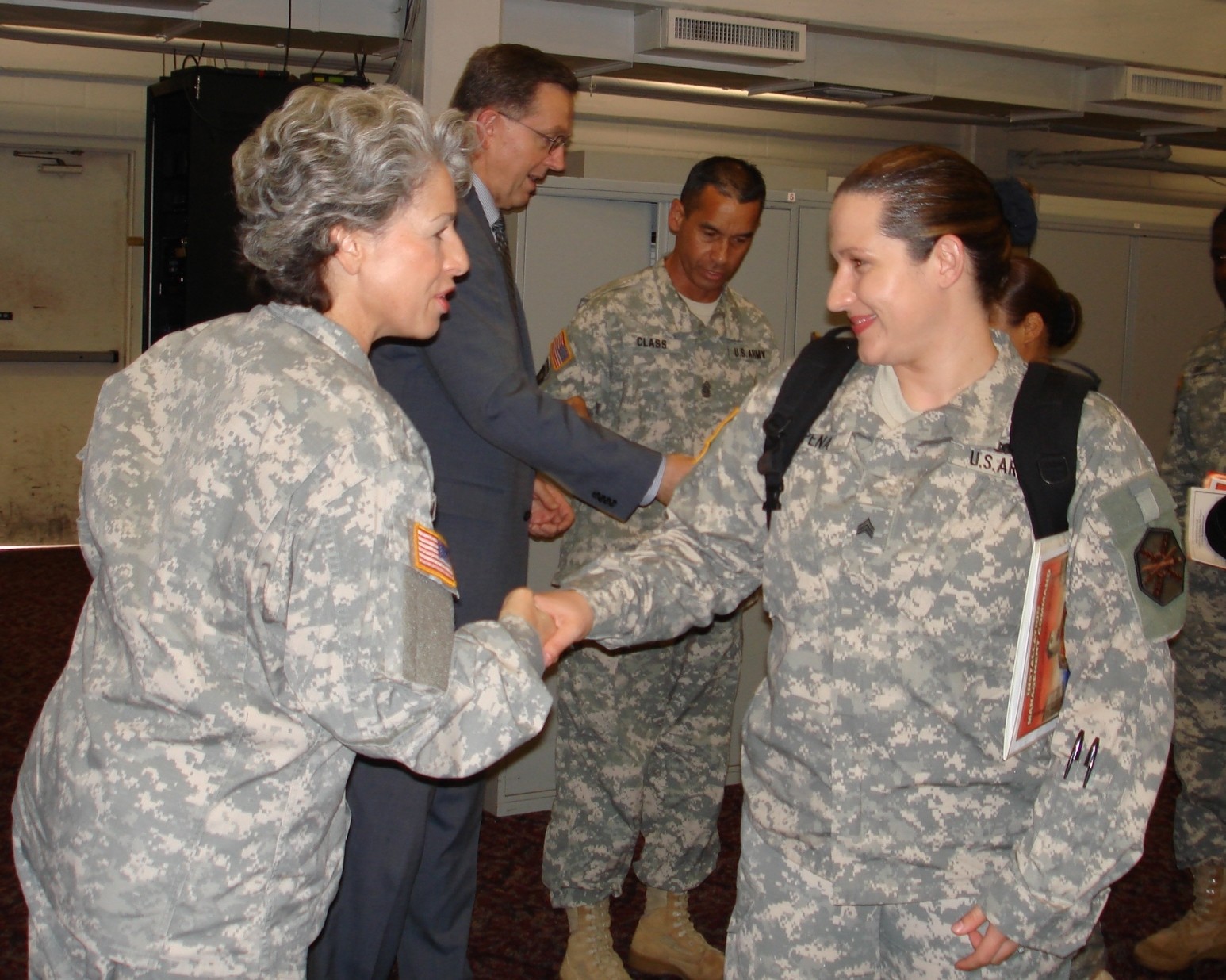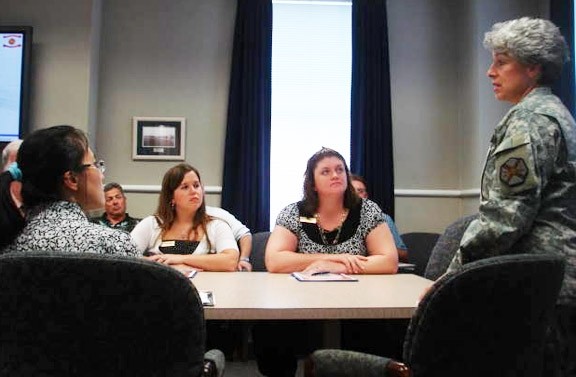FORT SAM HOUSTON, Texas --- Each month, newly assigned Soldiers, civilians and select contractors attend the Installation Management Command's mandatory welcome briefing, which is part of the Orientation for New Employees program.
Since August 2007, more than 200 U.S. Army Garrison Fort Sam Houston personnel have attended a briefing. The ONE program was created to pass on information about IMCOM to new employees and Soldiers.
Welcome to Fort Sam
The program is conducted in three phases. During Phase I, Inprocessing, new arrivals receive a welcome letter from their assigned office prior to or upon arrival to the organization. The director or office chief will also assign a sponsor to assist them with their inprocessing and help facilitate a smooth transition into the IMCOM Family of professionals.
Upon arrival, all civilian personnel report to the Fort Sam Houston Civilian Personnel Advisory Center; military service members report to the S1, Headquarters and Headquarters Company. Also during Phase I, all new employees receive a USAG inprocessing checklist that outlines all of their inprocessing requirements. This form is in addition to the standard military inprocessing checklist and civilian personnel checklist.
Introductions
During Phase II, Job Site Orientation, the new employee or Soldier receives an introduction to the organization, chain of command, facilities, office policies and procedures, performance and evaluations, goals of the organization, current projects and mission at the time, fire and safety procedures, computer competency, and other subjects aimed at helping the employee become part of the organization's team.
The first or second line supervisor usually conducts the Job Site Orientation, normally within three days of arrival to the organization. Upon completion, the supervisor submits the form to the Workforce Development Branch, Directorate of Human Resources.
Welcome briefing
Phase III, Formal Training, provides an organized presentation of Department of the Army policies. It is during this phase that the Workforce Development Branch conducts the welcome briefing with key members of the garrison team. After a brief introduction and administrative announcements by the director of Human Resources, the audience is introduced to the garrison commander, Col. Wendy Martinson.
For many of the attendees, the welcome briefing will be the only time during their assignment that they will be in the headquarters conference room, let alone get to speak directly to the garrison commander, especially without a supervisor, director or even company commander present.
As Martinson welcomes each new employee, she shakes their hand and presents them with an IMCOM lapel pin. In addition to the pin, attendees also receive a packet containing various reference materials that will be useful to them in their new jobs, to include copies of IMCOM 10-1 extract, chapter 17, Installation Command and Management; the Army, IMCOM and USAG FSH Mission, Goals and Objectives statements; the FSH Mission Essential Task List; and a list of mandatory training requirements, to include NSPS 101, Ethics, Prevention of Sexual Harassment, Anti-Terrorism/Force Protection and Computer Security Awareness.
Many of the attendees, especially Soldiers, are surprised to receive a personal greeting from the commander. After she finishes, the attendees' attention is directed toward the screen where they receive a formal welcome by the IMCOM-West Regional Director Randal Robinson. Robinson's video welcomes each person to the IMCOM Family. His first three words are "welcome, welcome and welcome." He tells them how important they are to IMCOM's mission and how they will help their organization and IMCOM accomplish the Army's goals. He concludes his greeting by telling the attendees if they ever see him on the street to "stop and say hello."
After Robinson's video Martinson informs the attendees of her priorities that include, but are not limited to, topics such as the Army Medical Action Plan, support to Warriors in Transition, the Army Family Covenant, installation infrastructure improvements and much more.
Looking back
Fort Sam Houston Public Affairs Officer Phillip Reidinger then gives a briefing on the history of Fort Sam Houston. Reidinger transports the audience back in time by talking about the rich heritage of Fort Sam Houston dating back to the early 1800s. Reidinger highlights a few interesting facts, such as Fort Sam Houston being the birthplace of Army aviation, and the story of Geronimo's imprisonment when he was housed in the Quadrangle, now home to U.S. Army North.
Additionally, Deputy to the Garrison Commander Michael Waldrop presents a command overview on the Army, IMCOM and garrison mission, goals and objectives. Waldrop briefly covers the Standard Garrison Organization, where he routinely asks the attendees to point out which directorate or special staff/office where they will work. As Waldrop tells them about the numerous missions and projects the various staff offices are working, they are amazed as to where they fit into the overall picture. The installation supports dozens of tenant activities, thousands of Soldiers, and tens of thousands of retirees on the installation on an annual basis.
What lies ahead
Waldrop is then followed by what is considered to be one of the most enlightening presentations during the welcome briefing - Transformation Overview, presented by Michael Hartman, chief, Fort Sam Houston Base Transformation Office. Hartman tells them about the dozens of units and tens of thousands of personnel relocating to Fort Sam Houston and Camp Bullis, along with the more than $2.4 billion in expenditures for dozens of new construction projects and facility upgrades, all part of the Base Realignment and Closure.
Next, attendees receive a brief overview on installation polices, anti-terrorism and force protection from Command Sgt. Maj. Pedro Class. Many of the young Soldiers always comment, "I feel honored to meet my sergeant major" or "I can't believe he took the time to brief us."
Finally, the welcome briefing concludes with informing attendees of their mandatory training requirements and the various resources available to them. Before the attendees exit the conference room, usually after about two hours, they have to complete an evaluation sheet that is used to inform higher headquarters, IMCOM-West. Comments are used to improve the briefing for the next round of attendees.
On the evaluations, attendees almost always comment positively about the commander's welcome, history of Fort Sam Houston and Base Transformation. Some of the comments include, "Wow, I didn't know all of this was happening on Fort Sam," "Now I know why there is so much construction on Fort Sam," and "The job opportunities are going to be endless, once BRAC is in full swing."
The goal of IMCOM's ONE program is to properly assimilate new employees into the organization, tell them where they fit, what's going on, and encourage them to jump right in and get busy. To that end, Fort Sam Houston has accomplished the goal of the program. Undoubtedly new employees to USAG Fort Sam Houston will feel proud to be a new member of the IMCOM Family. They will have the opportunity to make their mark on Fort Sam Houston's rich heritage.




Social Sharing